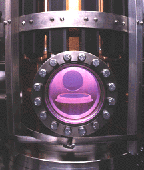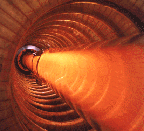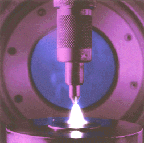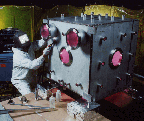|Home|Research|Industry|Education|Contacts|
 Photo: Multidipole- confined RF Inductive (MRFI) plasma source with magnetic bucket confinement, silicon wafer with separate RF self-bias supply and electrostatic chuck. |
Organization of Research Programs:Research areas of the ERC for Plasma-Aided Manufacturing span a wide range of plasma operating conditions. Research groups or Thrust Areas are:
In addition, the ERC has strong supporting programs called Support Groups in:
Direction of individual projects is determined with input from the ERC's various industrial partners. The research must be cross-disciplinary and have a well-defined goal aimed at improving industrial competitiveness. |
 Photo: Helicon reactor used for experimental plasma etching studies. |
1. Plasma Etching
Projects associated with this research all relate to plasma etching. A large variety of gas phase diagnostics (arguably the best in the world) and charged particle plasma diagnostics have been implemented to provide an extensive data base for modeling. Etching makes use of capacitive (parallel plate RIE), non-propagating inductive and propagating inductive (helicon) tools operating at 13.56 MHz and microwave tools operating at 2.45 GHz. These tools allow us to carry out state-of-the-art etching of silicon and polymer based substrates. Experiments explore improvements as well as basic understanding of etch processes and are aimed at real time control. |
2. Plasma Deposition and Polymerization
This area focuses on the plasma deposition of polymeric films, silicon compounds and the surface modification of polymeric and fibrous materials. This field has a very large number of potential applications for which it is important to develop techniques which utilize plasma deposition and polymerization in a wide variety of processes. The objectives of this research group are to optimize plasma deposition and/or polymerization process parameters with respect to key material properties, such as dielectric permittivity, residual stress, adhesion, wettability, dyeability, and permeability, and to understand the relationship between the plasma parameters and material properties. |
 Photo: Free-burning arc reactor used for thermal plasma processing of materials. |
3. Thermal Plasma
Coating Technologies
ERC activities in this area include plasma spraying, wire-arc spraying, and thermal plasma-assisted chemical vapor deposition (CVD). Researchers are combining diagnostics, including image analysis, modeling and statistical approaches, for the development of design guidelines for plasma spray coating equipment and for the implementation of process controls to assure reproducible quality of the coatings. Similar efforts are in progress in the field of wire-arc spraying. Thermal plasma CVD is primarily concerned with the production of high quality ceramic and diamond coatings at deposition rates between 10 to 100 µm per hour using both high frequency and dc plasmas. This research effort is centered at the University of Minnesota's High Temperature Laboratory. |
 Photo: Plasma Source Ion Implantation (PSII) chamber |
4. Plasma Modification of Materials
The mission of this area of ERC research is to modify the surface properties of materials including metals, glass, ceramics, polymers and semiconductors. The primary experimental technique utilizes implantation by Plasma Source Ion Implantation (PSII) and Ion Beam Enhanced Deposition (IBED) or ion beam mixing techniques. Use of this technique has substantially improved the surface hardness and wear resistance of certain materials in specific environments. It also has been used to produce implanted layers of new materials which can change the electrical, electronic and magnetic surface properties of bulk materials as well as to produce shallow implants for microelectronic applications. Another application involves improving the adhesion between conductive metal films and polymer substrates by depositing films using PSII-IBED. |
 Photo: Prof. Denice Denton and graduate student Reza Ghodssi at South Madison Child Development Pre-school. |
5. Engineering Education for the Future
The future success of the U.S. economy requires that some of our best and brightest young people choose to enter the engineering profesion. To this end, the ERC proposes to implement a cultural change approach to engineering education that will incorporate manufacturing across the engineering curriculum, bring manufacturing experts into the classroom, and broaden ethnic and gender diversity of the engineering work force. The program is entitled, Diversity and Cultural Change: Manufacturing Engineering Education for the Future. |
Support Groups:
These four activities are the basic tools through which the ERC conducts its specific research projects. |
|Home|Research|Industry|Education|Contacts|
 |
Last Modified: Friday,
August 22, 1997 02:20 PM This page is best viewed by browsers that support background colors in tables. All photographs © 1997 Engineering Research Center for Plasma-Aided Manufacturing. Address comments to ercpam@silver.neep.wisc.edu |